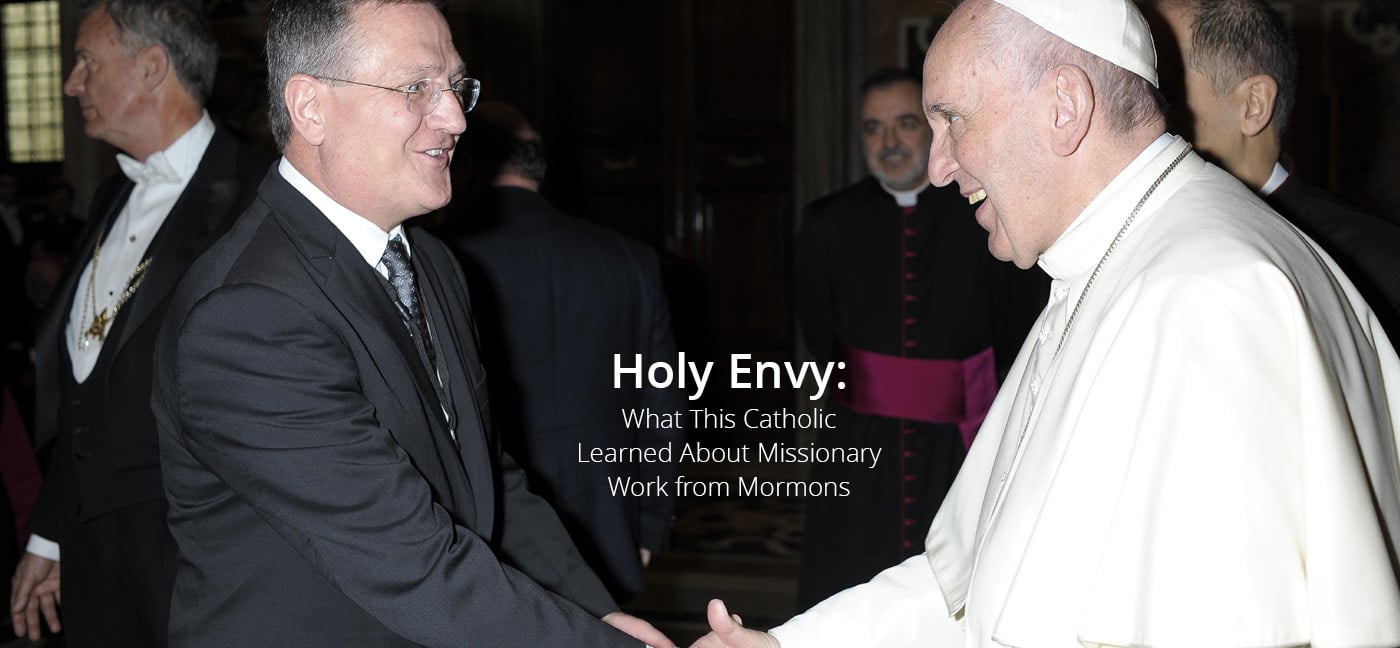Holy Envy: What This Catholic Learned About Missionary Work from Mormons
Brian Grim

“Where did you serve your mission?” That’s a typical question Mormons ask each other. And it’s one I can relate to. I served missions in China, the Soviet Union, and the Middle East, and converted from Baptist to Catholic along the way.
For a married Catholic like myself with four grown kids, that is perhaps a one-of-a-kind personal history. And even Mormons might view it as an unusual mission background. But I think it’s one that many members of The Church of Jesus Christ of Latter-day can relate to.
On occasion I’ve been asked what I might say to Pope Francis next time I meet him. If given the opportunity, I’d ask him a simple question: “How different do you think the world would be if every Catholic young person aspired to serve a two-year mission like Mormon young people do?”
It’s not just the time young adults spend serving a mission and the lives they impact that makes a difference. It’s also the years of spiritual, financial, and psychological preparation supported by friends, family and congregations that make a difference. This all adds to the spiritual and temporal strength of the LDS Church itself.
It’s not that Catholics don’t have mission programs. They do – FOCUS Missionaries (Fellowship of Catholic University Students), the Jesuit Volunteer Corps, and Maryknoll Mission Volunteers to name a few. The difference is that serving a mission tends to be the exception for Catholics rather than the rule.
Of course, there are aspects of the Mormon approach to spiritual and temporal affairs that make it more possible for them than for Catholics to field a global lay missionary force.
First, Mormons don’t have professional clergy. Their operations depend on volunteer lay leadership at the local level. LDS local pastors (what they call bishops) devote scores of hours each week to attending to the needs of their congregation, or “ward.” And at the stake level, what the Catholics might call a diocese, the leadership is also voluntary.
Second, they have special callings for people to take a break from their careers, often mid-career, and travel to different parts of the world at subsistence pay to head up the work. These mission presidents answer a call that requires them to put their professional lives on hold for three years in order to supervise hundreds of young Mormons getting their feet wet as missionaries. Catholics don’t have a parallel.
And third, active Mormons by-and-large tithe. They give 10% of their incomes as offerings to the LDS Church, which helps make the global missionary endeavor possible.
It’s not that Catholics couldn’t rise to the challenge – they do in countless ways – but such an endeavor would require a paradigm shift in how they approach missionary work.
Nevertheless, one potential advantage Catholics have is that their missionary endeavor is not centralized – not all mission callings need to go through the Vatican. That might seem like a disadvantage to many Mormons, but the closer an initiative is to the local beneficiary, the more likely people are to wholeheartedly support it. Just think of the tremendous benefit of Evangelical Christian missions such as the Gospel Rescue Missions. Their billion-dollar impact stems from the legion of volunteers that help in each city without any central coordination.
These days I’m not working as a missionary. Or, to be more precise, my mission is to promote freedom of religion and belief for all. In that task I’m happy to say there is more direct similarity between Catholics and Mormons.
The Mormon Prophet Joseph Smith said that anyone who “would trample upon the rights of the Latter-day Saints would trample upon the rights of the Roman Catholics.” In that sense, Joseph Smith was prophetic. We’re all in this together. In the 1960s the Vatican declaration on religious freedom – DIGNITATIS HUMANAE – acknowledged that it is the agency and response of each individual to promote salvation in Christ rather than rely on the government to defend what it deems to be “orthodox” beliefs.
Today, I’m heading the Religious Freedom & Business Foundation, which helps businesses, governments, and civil society see the pragmatic benefits of religious freedom. It’s another area where Catholics and Mormons have a lot in common. But that’s an essay for a different day.
Brian Grim is a member of the Roman Catholic Church. As president of the Religious Freedom & Business Foundation, he interacts with people of many different faiths around the world.
Editor’s note: This essay is part of an ongoing series on Holy Envy. People of various religions explain what they admire in other faiths. The purpose is to increase understanding and solidarity between believers.



